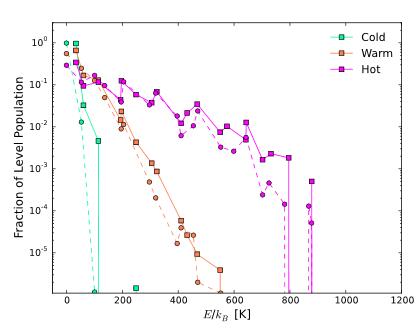Water provides a unique tool to probe the physical and chemical processes occurring in the galaxy nuclei and their surroundings. Unlike other molecular gas tracers traditionally used to study the dense, star-forming (SF) ISM in extragalactic systems (such as CO and HCN), water probes the gas exclusively associated with SF regions or heated in the extreme environment of active galactic nuclei (AGNs). The submillimeter and far-infrared (FIR) lines of water can be very prominent in actively SF galaxies, with intensities comparable to those of CO lines - much more prominent than other dense gas tracers such as HCN (e.g., van der Werf et al. 2011). The water lines not only probe the physical conditions of the gas-phase ISM (such as gas density and kinetic temperature) but also provide important clues on the dust IR radiation density as both collision with hydrogen molecules and IR pumping are important for their excitation (e.g., Weiss et al. 2010). In this work, we performed a systematic survey of multiple velocity-resolved H2O spectra using Herschel's Heterodyne Instrument for the Far Infrared (HIFI) for the first time. Our sample contains nine nearby actively star-forming galaxies, and our observations cover H2O transitions with Eup < 450 K including the ground-state lines of ortho and para H2O. We detected strong water emission and absorption in all galaxies except for the Antennae. We found that the H2O spectra show a diversity of line shapes. The medium-excitation H2O lines (130 < Eup < 350 K) are always detected in emission. Their line profiles typically resemble those of CO, indicating that water is widespread in the warm nuclear regions of active galaxies. The line profiles of ground-state and low-excitation H2O transitions (Eup < 130 K) often show a mix of emission and absorption. The emission features of these low-excitation lines usually display a wider velocity range than the medium-excitation lines, while the absorption features are often found to show more complex line profiles that differ from galaxy to galaxy. We analyze the HIFI observation together with archival SPIRE/PACS H2O data using a state-of-the-art 3D radiative transfer code – β 3D - that includes the interaction between continuum and line emission. The water excitation models are combined with information on the dust and CO spectral line energy distribution to determine the physical structure of the ISM. We identify two ISM components that are common to all galaxies: a warm (T ~ 40 - 70 K), dense (n(H) ~ 105 - 106~ cm-3) phase that dominates the emission of medium-excitation H2O lines. This gas phase also dominates the far-IR emission and the CO intensities for Jup > 8. In addition, a cold (T ~ 20 - 30 K), dense (n(H) ~ 104 - 105 cm-3), more extended phase is present. It outputs the emission in the dust low-excitation H2O lines and typically also produces the prominent line absorption features. Fig. 1 presents our predicted model (seen in top-left subplot) for the center region of NGC 4945. For the two ULIRGs in our sample (Arp 220 and Mrk 231) an even hotter and more compact (Rs <100 pc) region is present, which is possibly linked to AGN activity. We find that collisions dominate the water excitation in the cold gas and for the lines with Eup < 300 K and Eup < 800 K in the warm and hot component, respectively. Higher-energy levels are mainly excited by IR pumping. The gas-phase abundance of H2O varies from 10-9 to 10-8 in the cold ER to 10-8 - 10-7 in the warm component to 10-6 -10-5 in the hot component, suggesting that the water abundance is typically larger in the higher-density and warmer regions. 
By with LIU Lijie Fig. Note that the absorbing gas does not always have to be associated with the cold ER. For example, the ground-state/low-excitation H2O absorption detected in Arp 220 is found to arise from warm gas(possibly associated with molecular out flows driven by the nuclear activity)against the even warmer background radiation from the hot component. This paper was published in the Astrophysical Journal (2017, ApJ, 846, 5). Detailed information of the paper can be found at: http://adsabs.harvard.edu/abs/2017ApJ...846....5L |
